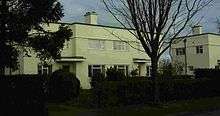Silver End
Silver End is a village in Braintree, Essex, in England. It was conceived as a model village by the industrialist Francis Henry Crittall who established a Crittall Windows Ltd factory there to manufacture components for metal windows.
| Silver End | |
|---|---|
 Silver End Location within Essex | |
| Population | 3,861 (2011)[1] |
| OS grid reference | TL8086719795 |
| District |
|
| Shire county | |
| Region | |
| Country | England |
| Sovereign state | United Kingdom |
| Post town | Witham |
| Postcode district | CM8 |
| Dialling code | 01376 |
| Police | Essex |
| Fire | Essex |
| Ambulance | East of England |
| UK Parliament | |
| Website | silverendparishcouncil.gov.uk |
History
Crittall, or "The Guv'nor" as he was known to his workforce, had a vision to provide his workforce with houses and amenities in close proximity to his window factory. Thus over six years from 1926 Silver End village was built. In 1928, a large department store was opened with 26 various departments under one roof; burnt down in 1951, it was re-built and today houses the Co-op and adjacent shops.

The village hall boasted a first class dance floor, cinema, library, snooker room and health clinic. It is the largest village hall in the UK.
The village includes some noteworthy early examples of Modernist architectural design; the distinctive white, flat-roofed houses on Francis Way and Silver Street are the work of influential Scottish architect Thomas S. Tait, a leading designer of Art Deco and Streamline Moderne buildings in the 20th Century who is also credited with designing the concrete pylons on Sydney Harbour Bridge. Of note are the steel window frames manufactured by Crittall's firm as a test for their use in the damp English climate.[2][3]
All major production ceased at the original Crittall site in 2006 when the factory was closed down. However, window frames are still manufactured at a Crittall factory in Witham.
The Factory Today
The majority of the buildings on the original factory site were demolished during the summer of 2008. Although these factory buildings were in the conservation area of the village, none of them were listed for conservation, although the developer agreed to retain the original 1926 factory and the Power House building, which originally generated electricity for the village. These factory buildings, which originally formed part of the intrinsic character of the village and an integral part of its raison d'etre - as a village in which to live and work, in Crittall's original concept - have thus now been lost. Most of the remaining factory buildings have been unused for some while.
There is now little employment within Silver End and it has become essentially a dormitory village. Any new dwelling houses constructed within the conservation area will be subject to the Article 4 Direction (Town and Country Planning Act 1990) which was served in 1983. This effectively removed 'Permitted Development' rights for replacement windows, doors, etc., on the dwelling houses in the Conservation Area to prevent further inappropriate alterations.
Local facilities
Silver End has several shops for the local residents but the nearest large supermarkets are a Morrisons in Witham and Tesco in Marks Farm (Braintree). Today, Silver End has a library, doctor's surgery, chemist, Chinese takeaway, fish & chip shop, a large Co-op supermarket and an Off-licence.
There are three churches, two playing fields, a pub (the Western Arms) and a workingman's club (Crittalls) and a primary school. Secondary schools are situated in and around Braintree and Witham; Alec Hunter Academy in Braintree, Maltings Academy and New Rickstones Academy (both in Witham).
Transport
Silver End is on a direct link by road to Braintree and Witham which are within a 10-minute drive. There are bus services to Braintree and Witham.
The nearest and most accessible main line railway station is at Witham, situated on the London Liverpool Street to Norwich main line via Hatfield Peverel, Chelmsford, Romford and Stratford; there is also a branch line to Witham from White Notley (railway station closest to Silver End).
References
- "Civil Parish population 2011". Neighbourhood Statistics. Office for National Statistics. Retrieved 6 September 2016.
- "Twenty-four semi-detached houses and terrace of eight houses". Dictionary of Scottish Architects. Retrieved 20 November 2008.
- Glancey, Jonathan (1998). "Silver End Housing Estate". C20th Architecture: The Structures that Shaped the Century. Carlton Books. ISBN 0-87951-912-6.
External links
| Wikimedia Commons has media related to Silver End. |